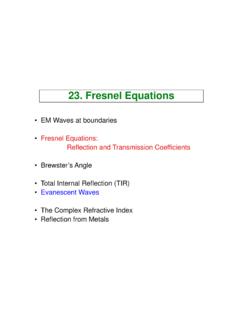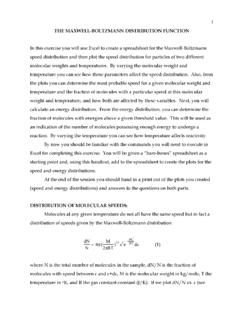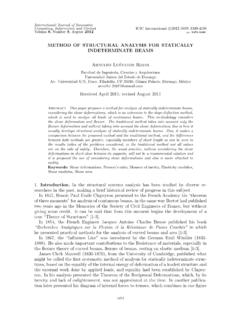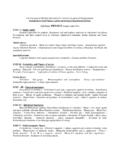Transcription of 32-1 Chapter 32
1 32-1 Chapter 32 maxwell 'sEquationsIn electricity theory we have two vector fields E and B,and two equations are needed to define each the total number of equations required mustbe many of the required equations have we discussedso far? We have Gauss law for the divergent part ofE, and Faraday s law for the solenoidal part. Itappears that we already have a complete theory of theelectric field, and we do. Gauss law and Faraday slaw are two of the four equations magnetism, we have Ampere s law that defines thesolenoidal part of B. But we have not written anequation involving the surface integral of B. We aremissing a Gauss law type equation for the magneticfield. It would appear that the missing Gauss law forB, plus Ampere s law make up the remaining is not quite correct. The missing Gauss law is oneof the needed equations for B, and it is easily writtendown because there are no known sources for a diver-gent B field.
2 But Ampere s law, in the form we havebeen using B dl= 0i(29-18)has a logical flaw that was discovered by maxwell corrected this flaw by adding anothersource term to the right side of Equation (29-18), hethen had the complete, correct set of four equations forE and 1860 James Clerk maxwell summarized the entirecontent of the theory of electricity and magnetism in afew short equations . In this Chapter we will reviewthese equations and investigate some of the predictionsone can make when the entire theory is does a complete theory of electricity and magne-tism involve? We have to fully specify the electric fieldE, the magnetic field B, and describe what effect thefields have when they interact with interaction is described by the Lorentz force law F=qE+qv B(28-18)which tells us the force exerted on a charge q by the Eand B fields. As long as we stay away from the atomicworld where quantum mechanics dominates, then theLorentz force law combined with Newton s second lawfully explains the behavior of charges in the presenceof electric and magnetic fields, whatever the origin ofthe fields may handle the electric and magnetic fields, recall ourdiscussion in Chapter 30 (on two kinds of fields) wherewe saw that any vector field can be separated into twoparts; a divergent part like the electric field of staticcharges, and a solenoidal part like the electric field ina betatron or inductor.
3 To completely specify a vectorfield, we need two equations one involving a surfaceintegral or its equivalent to define the divergent part ofthe field, and another involving a line integral or itsequivalent defining the solenoidal 32 maxwell 'S EQUATIONS32-2 maxwell 's EquationsAll maxwell did was to add one term to the fourequations for E and B, and yet the entire set ofequations are named after him. The reason for this isthat with the correct set of equations , maxwell was ableto obtain solutions of the four equations , predictions ofthese equations that could not be obtained untilAmpere s law had been corrected. The most famous ofthese predictions was that a certain structure of electricand magnetic fields could travel through empty spaceat a speed v=1/ 0 0. Since maxwell knew that 1/ 0 0 was close to the observed speed 3 108m/sfor light, he proposed that this structure of electric andmagnetic fields was light this Chapter , we will first describe the missing Gauss'law for magnetic fields, then correct Ampere s law toget the complete set of maxwell s four equations .
4 Wewill then solve these equations for a structure of electricand magnetic fields that moves through empty space ata speed v=1/ 0 0. We will see that this structureexplains various properties of light waves, radio waves,and other components of the electromagnetic spec-trum. We will find, for example, that we can detectradio waves by using the same equipment and proce-dures we have used in earlier chapters to detect andmap electric and magnetic LAW FORMAGNETIC FIELDSLet us review a calculation we have done several timesnow the use of Gauss law to calculate the electricfield of a point particle. Our latest form of the law is E dAclosedsurface=Qin 0(29-5)where Qin is the total amount of electric charge insidethe Figure (1), we have a point charge Q and haveconstructed a closed spherical surface of radius r cen-tered on the charge.
5 For this surface, E is everywhereperpendicular to the surface or parallel to every surfaceelement dA, thus E dA=EdA. Since E is ofconstant magnitude, we get E dAclosedsurface=EdAclosedsurface=E4 r2=Qin 0(1)where Qin = Q .rQ EFigure 1 Field of point solution of Equation (1) gives E = Q/4 0r2 asthe strength of the electric field of a point charge. Asimilar calculation using a cylindrical surface gave usthe electric field of a charged rod. By being clever, orworking very hard, one can use Gauss law in the formof Equation (29-5) to solve for the electric field of anystatic distribution of electric the simple example of the field of a point chargeillustrates the point we wish to make. Gauss lawdetermines the diverging kind of field we get from apoint source. Electric fields have point sources, namelyelectric charges, and it is these sources in the form ofQin that appear on the right hand side of Equation(29-5).
6 Figure (2) shows a magnetic field emerging from apoint source of magnetism. Such a point source ofmagnetism is given the name magnetic monopole andmagnetic monopoles are predicted to exist by variousrecent theories of elementary particles. These theoriesare designed to unify three of the four basic interactions the electrical, the weak, and the nuclear interactions.(They are called Grand Unified Theories or GUT theories. Gravity raises problems that are not handledby GUT theories.) These theories also predict that theproton should decay with a half life of 1032 the last 20 years there has been an extensive searchfor evidence for the decay of protons or the existence ofmagnetic monopoles. So far we have found no evi-dence for either. (You do not have to wait 1032 yearsto see if protons decay; instead you can see if one outof 1032 protons decays in one year.)
7 The failure to find the magnetic monopole, the fact thatno one has yet seen a magnetic field with the shapeshown in Figure (2), can be stated mathematically bywriting a form of Gauss law for magnetic fields withthe magnetic charge Qin set to zero B dAclosedsurface=0(2)When reading Equation (2), interpret the zero on theright side of Equation (2) as a statement that thedivergent part of the magnetic field has no sourceterm. This is in contrast to Gauss law for electricfields, where Qin/ 0 is the source 2 Magnetic field produced by a point 's Equationspath on the wire so that B and sections d of the pathare everywhere parallel. Thus B d=Bd, andsince B is constant along the path, we have B d=B d=B 2 r= 0iwhich gives our old formula B = 0i/2 r for themagnetic field of a see the flaw with Ampere s law, consider a circuitwhere a capacitor is being charged up by a current i asshown in Figure (4).
8 When a capacitor becomescharged, one plate becomes positively charged and theother negatively charged as shown. We can think of thecapacitor being charged because a positive current isflowing into the left plate, making that plate positive,and a positive current is flowing out of the right plate,making that plate (4) looks somewhat peculiar in that the currenti almost appears to be flowing through the have a current i on the left, which continues on theright, with a break between the capacitor plates. Toemphasize the peculiar nature of this discontinuity inthe current, imagine that the wires leading to thecapacitor are huge wires, and that the capacitor platesare just the ends of the wires as shown in Figure (5).Now let us apply Ampere s law to the situation shownin Figure (5). We have drawn three paths, Path (1)around the wire leading into the positive plate of thecapacitor, Path (2) around the wire leading out of thenegative plate, and Path (3) around the gap between theplates.
9 Applying Ampere s law we haveMAXWELL S CORRECTIONTO AMPERE S LAWAs we mentioned in the introduction, maxwell de-tected a logical flaw in Ampere s law which, whencorrected, gave him the complete set of equations forthe electric and magnetic fields. With the complete setof equations , maxwell was able to obtain a theory oflight. No theory of light could be obtained without s law, Equation (29-18), uses the line integralto detect the solenoidal component of the magneticfield. We had B d= 0ienclosedAmpere'sLaw(29-18)where ienclosed is the total current encircled by theclosed path used to evaluate B d. We can say that 0ienclosed is the source term for this equation, inanalogy to Qin/ 0 being the source term for Gauss we discuss maxwell s correction, let us reviewthe use of Equation (29-18) to calculate the magneticfield of a straight current i as shown in Figure (3).
10 In(3a) we see the wire carrying the current, and in (3b) weshow the circular magnetic field produced by thecurrent. To apply Equation (29-18) we draw a closedcircular path of radius r around the wire, centering theFigure 3 Using Ampere's 4 Charging up a (a)(b) ii++++++32-5 B dpath 1= 0ipath1goesaround a current i(3) B dpath 2= 0ipath2goesaround a current i(4) B dpath 3=0path3does not goaround any current(5)When we write out Ampere s law this way, thediscontinuity in the current at the capacitor plateslooks a bit more greater emphasis of the problem, imagine that thegap in Figure (5) is very narrow, like Figure (5a) onlyworse. Assume we have a 1 mm diameter wire and thegap is only 10 atomic diameters. Then according toAmpere s law, B d should still be zero if it iscorrectly centered on the gap. But can we possiblycenter a path on a gap that is only 10 atomic diameterswide?






